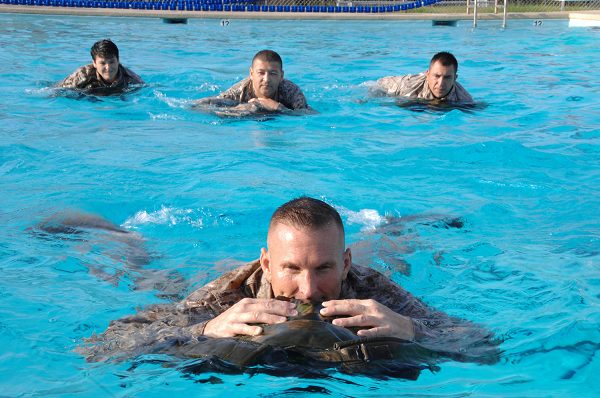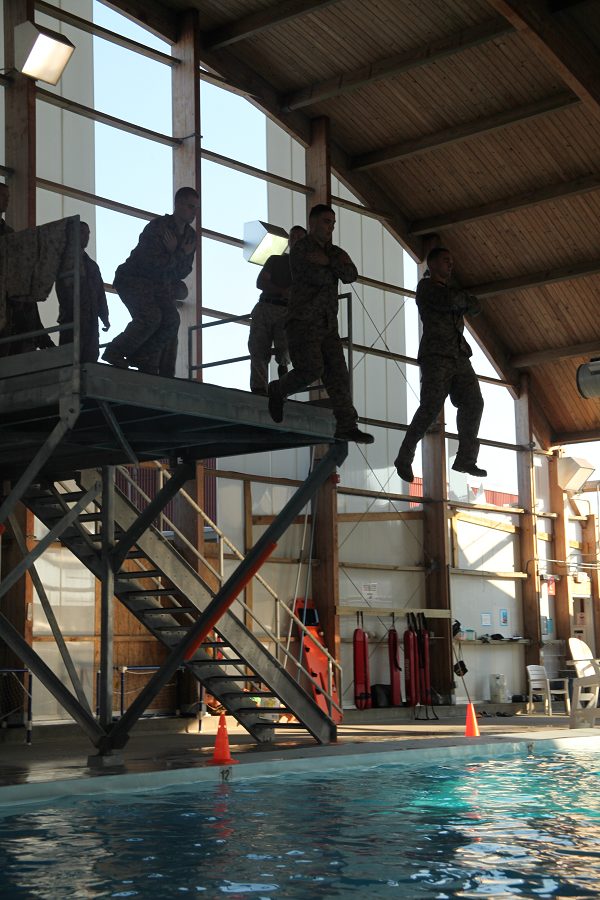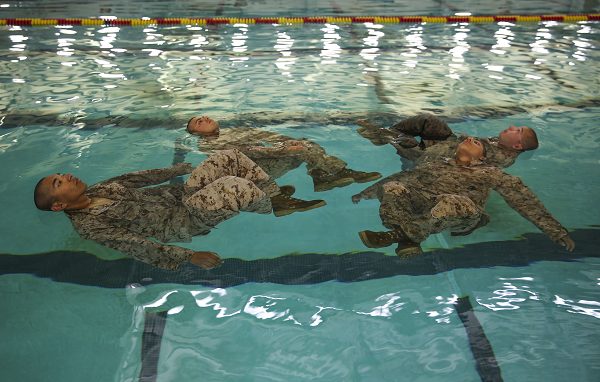All Marine recruits face water survival training to prepare for the USMC swim qual.
This training is in place to reduce fear and to raise your confidence that you can survive in the water in a crisis.
The Marines spend portions of their time on active duty on Navy vessels, so there is the necessity to train Marines to survive if they find themselves in the water in an emergency.
Also, even those who consider themselves good swimmers may find they struggle when faced with the reality of being fully clothed with all their gear and having abandoned ship.
The Marine Corps’ goal is to prepare all Marines for life-threatening real-world scenarios.
Safety is essential when preparing for the USMC swim qual because the test is not only focused on your physical abilities.
The Marines understand there is often a mental block when jumping into the water with all your gear and clothes.
Therefore, preparing before the USMC swim qual, it is essential to commit to safety before pushing your boundaries.
Related Article – How to Join the Military If You Are Overweight
What is the USMC Swimming Qual?

Since it is unrealistic to assume every Marine is a proficient swimmer able to navigate obstacles in a crisis, the Marines train and test members to ensure everyone has the same basic water skills.
The Marine Corps’ Water Survival Basic Qualification assesses several abilities.
As a recruit, you must successfully perform the following skills.
First, you must be able to get in the water with all your gear and shed your gear within ten seconds.
Next, you will simulate abandoning your ship by jumping into the water from a raised platform.
Once in the water, you will tread water for four minutes without holding on to the edge of the pool. You may use your gear to stay afloat.
Last, you will swim 25 meters while bringing your pack across from one side of the pool to the other.
Once you earn your basic qualification for swimming, your qualification is valid for two years.
Also, there are levels beyond basic, including intermediate and advanced.
How to Prepare for the USMC Swim Qual

To some, the USMC swim qual may seem easy.
However, it is vital to remember everyone has a different comfort level in the water.
Therefore, it is essential to prepare for this qualification carefully and with safety in mind.
While you get your plan together to guarantee your success at the USMC swim qual, consider these tips.
Get Professional Help at Your Local YMCA or Gym
Even if you are an experienced swimmer, consider signing up for instruction from a licensed professional.
For instance, you can look locally for an experienced swim instructor.
Also, check with your recruiter for a referral to an instructor who is knowledgeable of the USMC swim qual expectations.
Another option is signing up for a gym with a pool or your local YMCA.
Having access to a pool allows you to build some endurance and become more comfortable in the water before you face swim week at boot camp.
Lastly, sign up for a local swim test. Bring the expectations for the qualification to show your instructor and ask for help preparing for the unique challenges of the test.
Related Article – USMC Rifle Qualification
Self-Preparation for the USMC Swim Qual
If you are comfortable enough to prepare on your own, consider these exercises and techniques that could help you get more comfortable in the water, and build endurance.
There are exercises you can practice out of the water to perform during water training and to do well on the USMC swim qual.
Specific exercises would include:
Flutter Kicks
Flutter kicks work your core muscles.
Specifically, the exercise works the lower abs and your hip flexors, which help you in the water because it builds the strength and endurance necessary for swimming.
This exercise is performed on your back.
Place your hands under your buttocks and ensure your lower back is flat rather than arched off the ground.
Next, raise your legs twelve inches off the ground and alternate your legs going up and down.
Also, if you struggle with your legs being only twelve inches off the ground, raise them higher until your strength increases.
Start with two sets of twelve to fifteen repetitions working up to three sets.
Lateral Lunges
The lateral lunge works the muscles in the hips and the groin, so your hip rotation is stronger and more flexible while in the water.
When your hip rotation is strong, you will have a stronger swim stroke and more power in the water.
With a lateral lunge, you take a step to the side and drop into a low squat.
After coming back to the start position, you perform the same movement on the opposite side.
You want to perform 10 to 12 repetitions on each side.
Watch this short video for a demonstration:
Goblet Squats
The goblet squat builds the strength of the upper back and the lower body.
The squat is performed with your legs shoulder-width apart.
Also, you hold a dumbbell in your hands with your palms facing each other, cupping the top part of the dumbbell.
Keeping your shoulder blades tightly together, and your chin tucked, drop into a squat position with your spine tall.
After, use your hips to power yourself to the standing position.
If you are using a heavy weight for these squats, plan to perform three to five sets of three to five repetitions. If you are not tired with these few sets and reps, the weight may be too light.
For a more cardiovascular fitness goal, use a lighter weight, and perform eight to twelve reps and four to six sets.
Alternating Dumbbell Press
The alternating dumbbell press helps build shoulder stability, which is helpful in the water.
Shoulder stability is essential when swimming because of the overhead arm motions swimmers rely on.
To perform this exercise, lie on a bench face up and hold the dumbbells with straight arms above you.
Starting with one arm, lower your elbow until the dumbbell touches the outside of your shoulder.
After, raise it back up and proceed with the same movement of the other side.
Repeat this exercise for ten repetitions.
Lateral Pillar Bridge
The lateral pillar bridge is another exercise that builds hips rotation that translates into power in the water.
To perform this exercise, lie on the side of your body with your feet stacked your hips facing forward. You want your body in a straight line and your elbow under your shoulder.
Hold this position for three seconds and alternate.
Also, perform 10 on each side with your body strong and your head lined up with the spine.
Related Article – USMC PFT/CFT Calculator
USMC Swim Qual Self-Test
You can also consider enlisting the help of a friend or a trained swim instructor to do a practice test that mimics the USMC swim qual.
However, if you choose to do a mock test, it is vital to have a lifeguard on hand to ensure your safety.
Buoyancy Progressions
Treading water may sound easy, but it is more challenging than you may believe.
The leaner a person is, as many Marines are, the harder it is to stay afloat.
This is because muscles are denser than fat, so those with a higher BMI will have an easier time treading water.
However, lung capacity can help you out.
If you work to keep your lungs filled with air as much as possible, you will have a much easier time.
Therefore, inhale deep before a quick exhale.
Then, inhale deep again.
Another solution is to learn several kicking motions to help while treading water.
If you follow the workout mentioned above, your legs will be strong enough.
Some popular kicks for treading water include flutter kicks, as well as scissor kicks.
Also, progressing with an increasing amount of time treading water will help you build the endurance necessary.
Related Article – Marine Corps Boot Camp Graduation
Conclusion
The Marine Corps is aware that Marines may find themselves in a situation where water survival skills are critical.
Therefore, the USMC swim qual ensures that all soldiers are not just proficient swimmers, but able to survive water in situations that mimic having to abandon a ship with clothes and gear.
You can prepare for the USMC swim qual well in advance.
Preparation involves some time in the gym working muscles that help you become a stronger swimmer.
Also, by increasing your lung capacity, you will become more buoyant.
However, in all cases, safety is paramount when preparing for the USMC swim qual.
References:
- 5 Best Jobs for Female Marines - June 20, 2024
- 10 Best Marine Corps Recruiting Videos of All Time - June 20, 2024
- Marine Corps Requirements - June 20, 2024
Originally posted on September 12, 2020 @ 5:05 pm
Affiliate Disclosure: This post may contain affiliate links. If you click and purchase, I may receive a small commission at no extra cost to you. I only recommend products I have personally vetted. Learn more.

